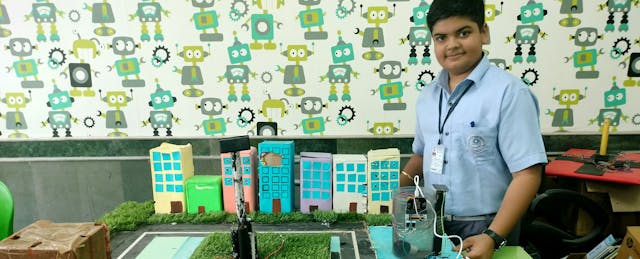Youth voice is vital in the development and implementation of artificial intelligence (AI) tools. Youth today are significant users of technology and have dominated AI-related conversations, so it’s essential to provide opportunities for them to design and problem solve the tools that are shaping their future. How can we empower youth to become key voices and leaders who actively shape and improve emerging AI technology, ensuring it positively impacts their communities? Initiatives like the YouthMADE Festival, a two-week celebration in May that showcases youth-led work around the globe, have shown that younger generations are the creators and changemakers in their communities.
Student teams in Delhi, India, took action to build solutions in their local communities that address the United Nations’ 17 Sustainable Development Goals. One of their projects involved building an AI sensor boat to monitor the water quality for the protection of local villagers and aquatic life. This project was guided by Anni Kumar, a seasoned educator and head of the computer science department at Vikas Bharati Public School.
Kumar believes prioritizing youth voice can bring fresh and innovative ideas to the development of AI tools. Kumar has been a teacher for 19 years and is passionate about creating a learning environment that fosters critical thinking, collaboration and creativity among her students. This past year, Kumar and her student team were the recipients of the 2023 Ciena Solutions Challenge Sustainability Award, a global design challenge inviting students and teachers to design solutions to real problems and take action to build a better world. We spoke with Kumar about her experience with student-led design projects using AI technology.
EdSurge: How did you get students started in using AI to design solutions?
Kumar: Before diving into designing solutions with AI, students were trained in the basic understanding of what AI is, how it works and what it can be used for. Once the students had a basic understanding of AI, they were asked to identify a problem that they wanted to solve using AI. After identifying a relevant problem, students collected data to train their AI models and analyzed the data using different tools like Excel, Google Sheets or other data analysis software. Students researched and chose an AI model that was appropriate for the problem they were trying to solve. After the model was trained and tested, students used it to solve a local problem in their community such as trafficking, drowsy driving and COVID-19. With the right resources and tools, students were able to make a significant impact in the communities through AI solutions.
What impact do student-led projects have on your community?
Student-led AI projects have a significant impact on communities in a variety of ways. Student projects helped to improve accessibility for individuals with disabilities by developing an AI-powered system that helps to translate spoken language into sign language for the deaf and hard of hearing. One group of students used AI in education, which helps children get personalized learning experiences such as through a Universal Design for Learning approach. Students can better understand complex concepts and thus improve their academic performance. By using AI to solve real-world problems, students are helping to create a better future for all.
What are the benefits of prioritizing youth voice in the development of AI tools?
Youth bring diverse perspectives and experiences that may be overlooked by adult developers. Involving youth in the development of AI tools can empower them to become active creators of technology rather than passive consumers. This opportunity can inspire them to pursue careers in technology and provide them with the skills and confidence needed to succeed in these fields. Youth are often the most impacted by the technologies they use, and involving them in the development of AI tools can help ensure that these tools address their needs and concerns. AI tools can have a significant social impact, and engaging youth in their development can ensure that these tools are created with a social conscience. This ensures that AI tools are not only effective but also responsible and ethical.
Were there any challenges in using AI for your projects?
One of the most significant challenges was ensuring that the data used to train AI models was accurate and unbiased. Students came to understand that if the data were of poor quality or biased, the AI model would be inaccurate and even reinforce existing biases. Developing AI projects also required specialized skills, expertise, additional time and funding. We called on industry experts and collaborated with different tech companies to provide technical support and workshops for students. Developing and implementing AI projects was very expensive, requiring specialized hardware and software. To support this, I also collaborated with tech companies to fund the AI projects.
What advice would you give to stakeholders considering collaborating with youth in the use or development of AI tools?
Collaborating with youth requires creating a safe, supportive environment that encourages open communication and feedback. Foster a sense of ownership among youth by giving them a sense of responsibility and autonomy in the project. This can help ensure that they are invested in the project and motivated to contribute to its success. Youth may need additional training or support to develop the skills needed to participate effectively in AI projects, so providing opportunities for learning and skill development, including training sessions and access to resources, should be considered. To ensure that youth are genuinely involved in the project, it's important to incorporate their feedback throughout the process. Lastly, AI tools can have significant ethical implications. It's crucial to consider the potential impact of the AI tool on society, including issues such as privacy and bias, and involve youth in these discussions.
How are your students creating and making a difference in their communities? Help them showcase their work and hear from other like-minded peers around the globe at the next YouthMADE Festival, a global celebration showcasing youth creativity and innovation from May 15–28. Learn how to host a student showcase at youthmade.org!



